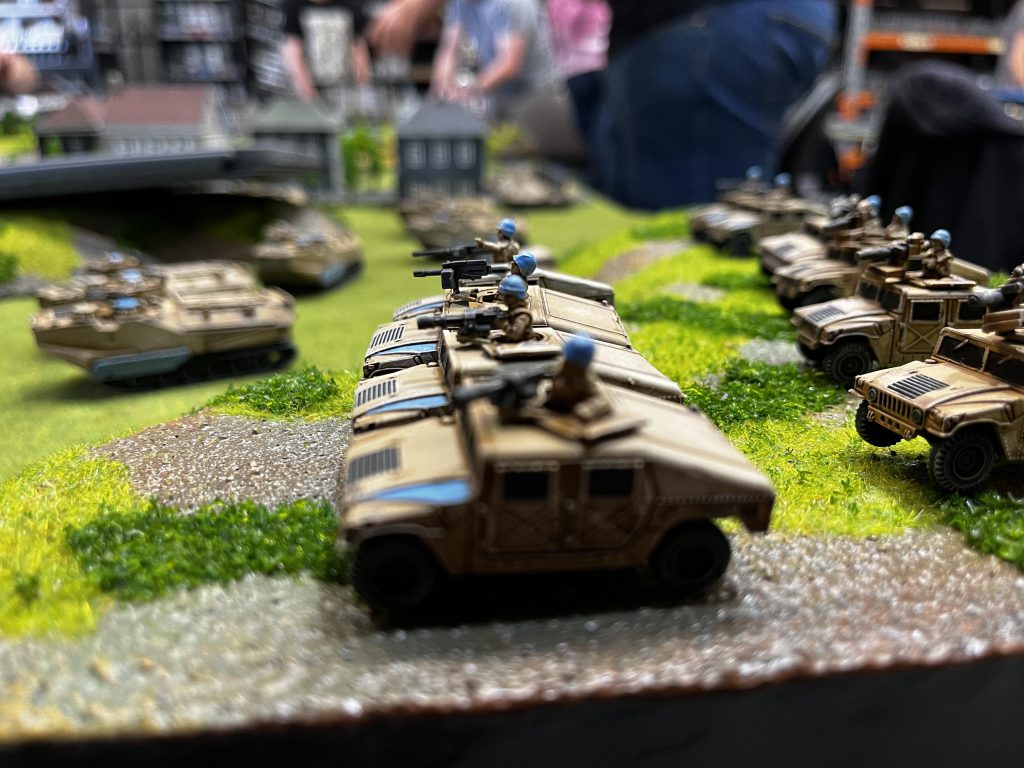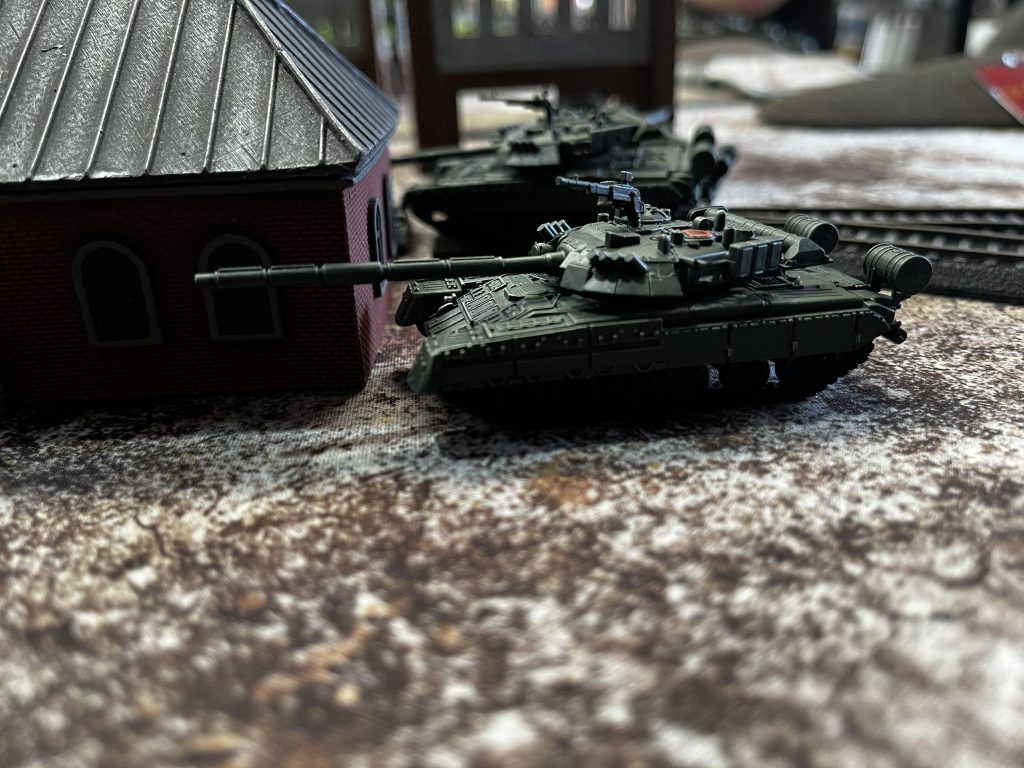Wake up, babe, new World War just dropped
Welcome to World War III: Team Yankee, where the tanks are small and the battles are huge.
It’s 1985, and quite a lot of people are about to share a significant emotional event. Following the death of Leonid Brezhnev in 1985 the Soviet Central Committee has opted not to appoint the reformer Mikhail Gorbachev in his place, and instead chooses violence. Team Yankee, a company-sized element of the US Army’s forces in West Germany, is about to dish out some good old-fashioned American diplomacy – 120 millimetres at a time.
Your hosts Davey and Sockbert are taking a break fighting off drop bears down under to try this Cold War-era wargame, driven largely by Sockbert’s erratic approach to owning a credit card. Davey could have said no. He knows he could have said no. Sometimes, he wonders what life would be like if he had only said no.
Davey’s joining up with the Warsaw Pact, with the humble goal of breaking the world record for the vertical turret toss. Sockbert has boldly decided to play as the good guys, building British and American armies with the ultimate goal of breaking another shelf under the weight of their miniatures. Oh, they bought some West German stuff too. And Swedes. Honestly, there might be more – we haven’t heard from them since lunch.
Anyway, there’s no time to explain – get in the tank.

Why you should play WWIII: Team Yankee
Tanks! Tanks! Tanks! Tanks! This is a tank game about tanks, for tanks, probably by tanks. Sure, there’s infantry, IFVs, helicopters, and planes, and sure, they’re super fun and cool, but name another game where you can happily throw down thirty hulls and still do well.
It’s a “what-if?” historical. Set in an alternate history where the Cold War suddenly goes hot in August 1985, it answers the question: “what if we got to use all these fun toys after all?” You’ll take real tanks to real places and fight battles that never happened.
It’s as deep as you want it to be. Unlike Games Workshop systems, every army here plays with the same rules, with differences coming in kit and skills rather than racial abilities or majorly different statlines. You don’t need to learn dozens of faction-specific stratagems or bits of wargear, but flexibility in army builds and the tactics each nation brings means there’s plenty of depth here for those who want to dig in.
Play with all your toys. This is a game system that enshrines your ability to bring all your little dudes along together. While formations – the basic building blocks of an army list – have their own limitations, you can always bring units from other parts of your faction or even bring entire allied formations along for the ride. If your Brits feel too civilised, an allied company of Australians will fix that right up.
Entry is cheap, expansion is optional. If you want to be able to sit down and play this game with a full-sized force, the cost of entry can be less than the price of an Imperial Knight from Warhammer 40,000. A few of the starter boxes can build more than a standard sized force, and while some factions (mostly the Soviet side) can cost a little more it’s generally far less than other popular wargames. That kind of single-box force may not be optimised for a tournament win, but it’s a legal army that will give you a great time. Or, you can spend more and experience Sockbert’s Bucket O’ Humvees! Keep an eye out for future articles about getting started with each Team Yankee faction.

A pedigree older than the authors
Team Yankee is a tabletop sort-of historical wargame with a wild history. The game is based on H. W. Coyle’s debut novel Team Yankee, first published in 1987 and itself set within General Sir John Hackett’s Cold War-turned-hot scenario The Third World War. The novel spawned three video games, a graphic novel, a comic book series – and now a tabletop wargame. We’re here to talk about the game, but lord, we really need to tell you about the book.
You can place Team Yankee’s parent novel on the bookshelf between Dan Brown and Matthew Reilly: popular as hell (within its niche), but the critics call it trash (honestly so do most of the people who enjoy it as well). The story follows Team Yankee, a company-sized armoured group in West Germany led by Captain Sean Bannon, as they overcome both the might of the Soviet Army and the incompetence of their brothers-in-arms. It still bears a 4.3 star average rating on Amazon, visible hilariously right beside a “product issues have been reported” warning. Professionals have been less kind than the public: Lieutenant-Colonel Chris Johnson of the Australian Army called the protagonist “an entitled, fluky, egotistical wanker” in a review published at The Cove, an official website of the Australian Defence Force. I’ve never been more proud to be Australian and – with complete honesty – it’s only made me want to read it more. There may be a full review in Goonhammer’s future; stay tuned.
Being ultra-polarising doesn’t seem to have restrained Team Yankee’s success. The current wargame, based on Battlefront Miniatures WW2 themed Flames of War system, was published in 2015 and is still thriving in its second edition. It also enjoys a steady flow of new miniatures and rules today, with multiple major faction releases (including the best, Australia) and updates just in the last few months.
So what’s this game all about, then?

Introducing the wargame
Having staged more than half a million men in Eastern Europe under the guise of a “mobilisation exercise,” the Soviet Army crosses borders into the West and slams into surprisingly determined and well-equipped defenders. If any of this sounds at all familiar, I’ll remind you that Team Yankee is a work of fiction and that all similarities with persons living or dead or actual events is purely coincidental. Just sit back and enjoy the tanks. And there are, like, a lot of tanks. God damn there are a lot of tanks.
Team Yankee is the child of the Flames of War game system, and its design is broadly similar to many other tabletop wargames. Starting with one of the twenty-six playable countries, players construct an army list using formations as building blocks and smash them together in a range of different narrative and competitive mission types. We’ll discuss list construction in more detail in a future article, but the deal is pretty similar to previous editions of Warhammer 40,000: pick a faction, pick one of the available force structures (tank battalion, infantry battalion, and so on), and fill it out with units. Your core force can also have a bunch of tag-alongs from outside the force structure, allowing you to add a little flavour or balance to your army.
The overall feel of Team Yankee leans away from raw competition and more towards play for fun. That’s probably for the best in a game that pits swarms of T-55s designed in 1947 against modernised Abrams and Leopard 2 tanks that are still being built today. This is a tank game at first glance, but building a force that includes no tanks at all is both normal and common – you might instead bring an airborne battalion that arrives entirely by helicopter, or a massive swarm of infantry. There are so many nations, units and mission designs in this game that the matchups are often unpredictable and frequently memorable. That’s not to say that you can’t play competitively (and there are numerous national and international championships), but more that the army building process almost enforces “realistic” or narrative builds; you can’t just spam the best three units your army book has and hope to do well.
The game flows like many others, with players alternating their turns with only limited interruption. You’ve got your traditional morale, movement, shooting and assault phases, spiced up with some unit reserve shenanigans (look, the Air Force are busy lads, they can’t always be expected to arrive every turn, can they?) and a dedicated artillery phase for those of you who, like Davey, think that an infantryman’s final form is a fine red mist. Terrain is a massive deal in this game: most units are hit on a fixed number, shown on their unit card, and terrain is the best way of keeping them alive by modifying the required roll. Hiding behind rubble might make you harder to hit, while letting your enemy get around that rubble to hit you in the weaker flank armour may spell doom to your tiny tanks. But look on the bright side: every dead tank is a new source of cover.
Frontal assaults rarely work; you’re going to be bouncing a lot of shots if you just try and throw gunpowder at the enemy to see what happens, and you’ll often end up just stunning a vehicle’s crew instead of making an engine kill. Finally, infantry have their chance to get up close and personal, trying to push opposing infantry out of defensive positions or ramming grenades down the hatches of tanks None of this is likely to be new to you, it’s a wargame built with familiar pieces but put together in their own way. Team Yankee is all about simple decisions having complex results, and that gives it a lot of depth.
Game time can be wildly variable, more so than other wargames we’ve played. A clash of two elite tank teams is going to be fast, with each player vying to find just that right shot before removing big chunks of an army at a time. By comparison, Sockbert’s bucket-o-boys approach to army building can really test the limits of a round time. With every army sharing the same basic rules, delays from checking out your codex don’t really happen but finding that specific core rule can sometimes be challenging. The main rulebook is laid out in a way that is very logical to some players, and completely inane to others (hint: us). Either way, it works because of the simplicity of the core mechanics, letting you get straight into the core business of bullying the French once more.

Where to from here, sir?
We think Team Yankee is delightful mix of both silly tank spamming fun, deep strategic play, and enjoyable for the history nerd in all of us. There are a broad range of options for new players, pretty much anyone reading this can play the nation they live in, and the communities we’ve seen continue to grow. We’ve played games as small as thirty points all the way up to two hundred and found it’s a pretty good time at all levels. We’re pretty excited to play on, and we’re taking you with us.
Over the coming months, Sockbert and Davey will be reporting on our experience of getting into this delightful little wargame. We can’t wait to tell you how to get started with the game and its major factions, how to paint your miniatures, and fill you in on our tournament experiences. Check back soon as we give you the quick and easy way to start your first Team Yankee force and get started exporting some high explosive diplomacy!
Questions, comments, suggestions? About to drop a ten thousand word essay on fulda gap defence on us? contact@goonhammer.com or leave a comment below


